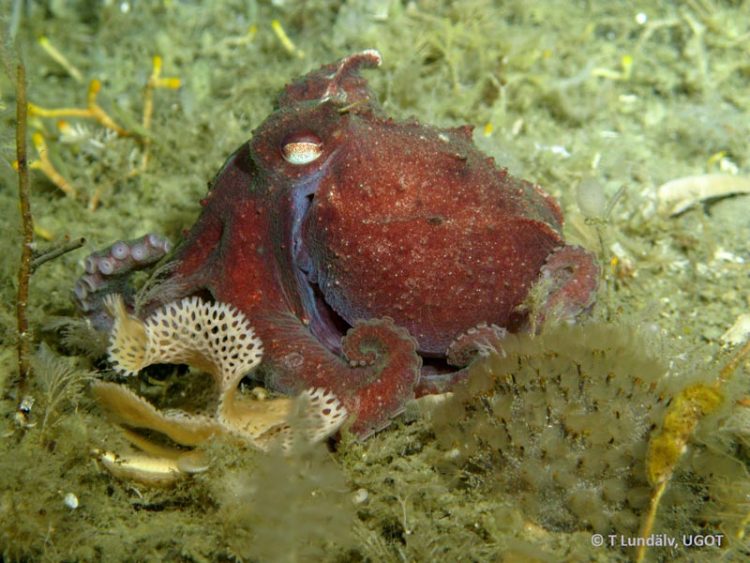Blue blood on ice – How an Antarctic octopus survives the cold

<b>Pareledone</b> Antarktischer Krake Pareledone sp. Das Foto muss zitiert werden als "Tomas Lundälv" nach Nutzungsfreigabe durch den Urheber (tomas.lundalv@loven.gu.se - Anfragen bitte auf Englisch: request for permission of use in the newspaper/on the website )
The study suggests that the octopus’s specialized blood pigments could help to make it more resilient to climate change than Antarctic fish and other species of octopus.
The Antarctic Ocean hosts rich and diverse fauna despite inhospitable temperatures close to freezing. While it can be hard to deliver oxygen to tissues in the cold due to lower oxygen diffusion and increased blood viscosity, ice-cold waters already contain large amounts of dissolved oxygen.
In Antarctic fish, this reduces the need for active oxygen transport by blood pigments (e.g. haemoglobin), but little is known about the adaptations employed by blue-blooded octopods to sustain oxygen supply in the cold.
Lead author Michael Oellermann from the Alfred Wegener Institute, Germany, said: “This is the first study providing clear evidence that the octopods' blue blood pigment, haemocyanin, undergoes functional changes to improve the supply of oxygen to tissue at sub-zero temperatures. This is important because it highlights a very different response compared to Antarctic fish to the cold conditions in the Southern Ocean. The results also imply that due to improved oxygen supply by haemocyanin at higher temperatures, this octopod may be physiologically better equipped than Antarctic fishes to cope with global warming.”
Octopods have three hearts and contractile veins that pump ‘haemolymph’, which is highly enriched with the blue oxygen transport protein haemocyanin (analogous to haemoglobin in vertebrates).
To find out what makes the haemocyanin of an Antarctic octopus so well-adapted to cold water, the researchers collected and analyzed the haemolymph from the abundant Antarctic octopod species Pareledone charcoti, and two octopod species collected from warmer climates – the South-east Australian Octopus pallidus and the Mediterranean Eledone moschata.
The Antarctic octopus Pareledone charcoti had the highest concentration of haemocyanin in its blood – at least 40% more compared to the other species, and ranked amongst the highest levels reported for any octopod. The researchers say that these high blood pigment concentrations may be compensating for the haemocyanin’s poor ability to release oxygen to tissues while in cold environments, and could help to ensure sufficient oxygen supply.
The Antarctic octopod haemocyanin was also found to shuttle oxygen between gills and tissue far better at 10°C than at 0°C. At 10°C the Antarctic octopod’s haemocyanin had the potential to release far more oxygen (on average 76.7%) than the warm-water octopods Octopus pallidus (33.0%) and Eledone moschata (29.8%). This ability may help the Antarctic octopod tolerate warmer temperatures in addition to the cold, and may link to the life style of Pareledone charcoti, which is also reported to reside in warmer shallow waters and rock pools.
Considering the strong warming trend at the Antarctic Peninsula, Pareledone charcoti may eventually benefit from its capacity to adjust blood oxygen supply to more variable temperatures than other species, including Antarctic fish.
The new findings show how the blood pigment haemocyanin in octopods is able to support oxygen supply in both cold and warm environments, and could help explain why octopods remain so populous across a wide spectrum of ecological niches.
While haemocyanin has proved to be crucial to Antarctic octopods, more comprehensive insight is needed to predict their fate in a warming ocean.
Notes for Editors
Original publication:
Michael Oellermann, Bernhard Lieb, Hans O. Pörtner, Jayson M. Semmens and Felix C. Mark
Blue blood on ice: Modulated blood oxygen transport facilitates cold compensation and eurythermy in an Antarctic octopod. Frontiers in Zoology 2015, http://dx.doi.org/10.1186/s12983-015-0097-x
Your scientific contact person is Michael Oellermann (e-mail: michael.oellermann(at)awi.de). Your contact person in the Dept. of Communications and Media Relations is Folke Mehrtens (phone +49 471 4831-2007; e-mail: Folke.Mehrtens(at)awi.de).
The Alfred Wegener Institute conducts research in the Arctic, Antarctic and in the high and mid-latitude oceans. The Institute coordinates German polar research and provides important infrastructure such as the research icebreaker Polarstern and research stations in the Arctic and Antarctic to the national and international scientific world. The Alfred Wegener Institute is one of the 18 research centres of the Helmholtz Association, the largest scientific organisation in Germany.
Media Contact
All latest news from the category: Life Sciences and Chemistry
Articles and reports from the Life Sciences and chemistry area deal with applied and basic research into modern biology, chemistry and human medicine.
Valuable information can be found on a range of life sciences fields including bacteriology, biochemistry, bionics, bioinformatics, biophysics, biotechnology, genetics, geobotany, human biology, marine biology, microbiology, molecular biology, cellular biology, zoology, bioinorganic chemistry, microchemistry and environmental chemistry.
Newest articles

Properties of new materials for microchips
… can now be measured well. Reseachers of Delft University of Technology demonstrated measuring performance properties of ultrathin silicon membranes. Making ever smaller and more powerful chips requires new ultrathin…

Floating solar’s potential
… to support sustainable development by addressing climate, water, and energy goals holistically. A new study published this week in Nature Energy raises the potential for floating solar photovoltaics (FPV)…

Skyrmions move at record speeds
… a step towards the computing of the future. An international research team led by scientists from the CNRS1 has discovered that the magnetic nanobubbles2 known as skyrmions can be…





















